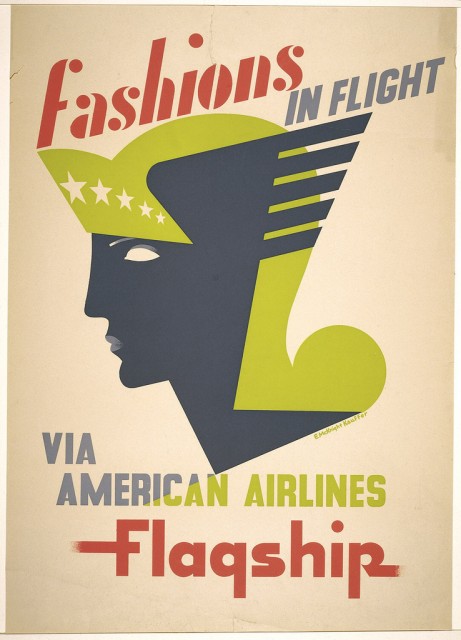The Object of the Day for October 3, 2013 featured one of the last posters the celebrated poster artist E. McKnight Kauffer produced in England. After experiencing 25 years of commercial success as a graphic designer, the outbreak of World War II meant that commissioned work dried up and, as an American citizen, he was forced to return to his native country. He arrived in New York in mid-July 1940 (with his partner, the textile designer Marion V. Dorn—they married in 1950) with no money and no immediate prospects.
He set about designing book jackets for the Modern Library imprint and Alfred Knopf, and offered his services to a number of war-time organizations, designing posters for the Office of Civilian Defense, the CAA Air Training Service, the American Red Cross, and the US War Bond Drive. Seeking more remunerative work he was introduced to a man who was to become an important friend and benefactor. Bernard Waldman, owner of the Modern Merchandising Bureau, remembered seeing Kauffer for the first time. “He was directed to my office. [He was] tall, thin, sensitive face, red-brown hair, carefully brushed, and extremely well-dressed…He looked more like a college professor with four or five books under his arm”. From this meeting, in early 1943, a life-long friendship developed. Waldman found him work, often taking a risk by introducing his clients to Kauffer’s uncompromising style of design. In 1945 Waldman received a large poster commission from American Airlines that he entrusted to Kauffer, again a risky tactic, but Waldman was so convinced they would be a success that he told the company it wouldn’t have to pay if it did not like them.
Over a five-year period Kauffer produced thirty posters for American Airlines (most of these are in the Cooper-Hewitt collection). As is the case with much of his work the style varies according to the perceived problem. Some of the American Airlines posters show a cityscape, others a pastoral scene, but many of them reflect his modernist and symbolic approach to design. The one I have chosen is indicative of the latter and is, to some extent, redolent of his work from a much earlier era. The stylized silhouette of a winged helmet-wearing Greek goddess, rendered in an unusual combination of dark gray and olive green, is, perhaps, intended to be symbolic of the flagship’s figurehead. It is not clear, however, from the poster alone what exactly is being advertised. Could it be that the American Airlines flagship was the most stylish mode of air travel of the time, or was it a comment on the contemporary look of the flight attendants’ uniforms?
In his struggle to gain a credible reputation as a graphic designer in New York the series of American Airlines posters (and six posters for Pan American airlines—also in the Cooper-Hewitt collection) gave Kauffer some regular, high profile work. Some years after McKnight Kauffer’s death Bernard Waldman disclosed that he once received a letter from the president of American Airlines stating that Kauffer’s series of posters for his company were the best they ever had.
Dr Graham Twemlow, whose Doctorate thesis focused on an investigation into the posters of E. McKnight Kauffer, is an academic and design historian.
